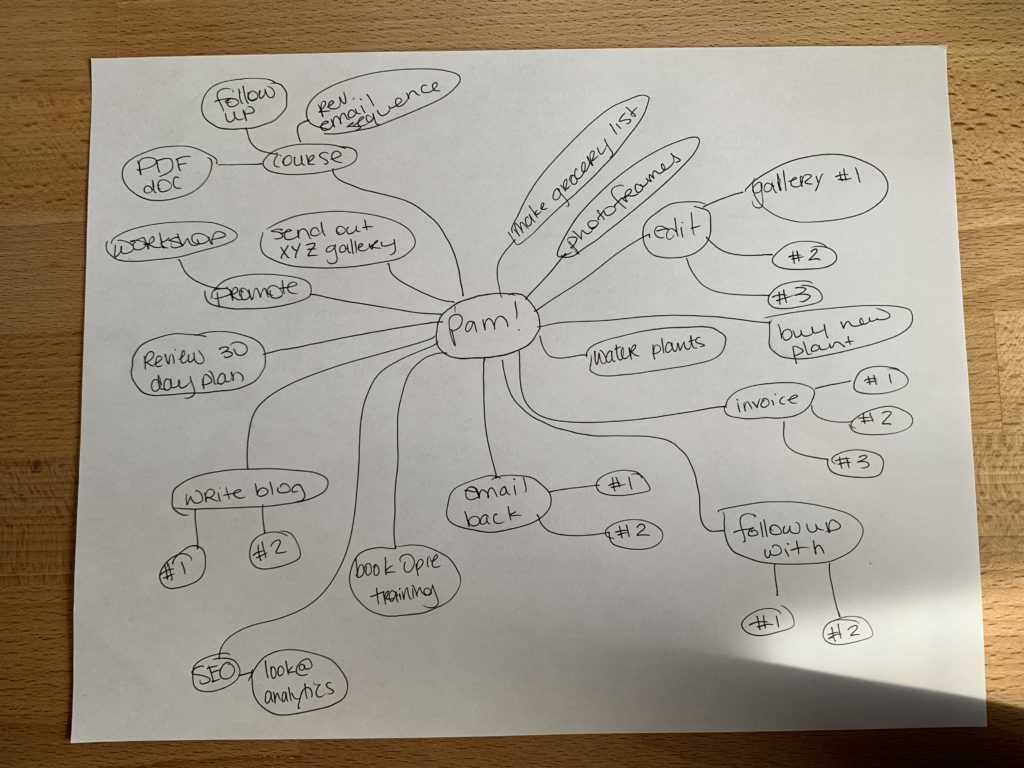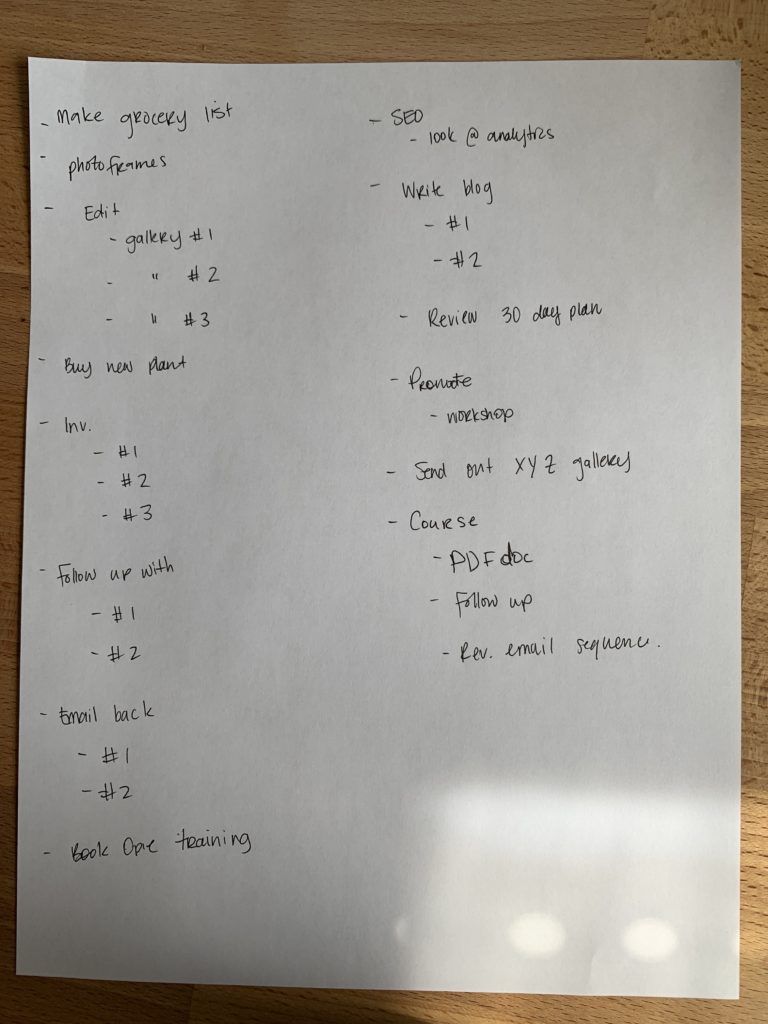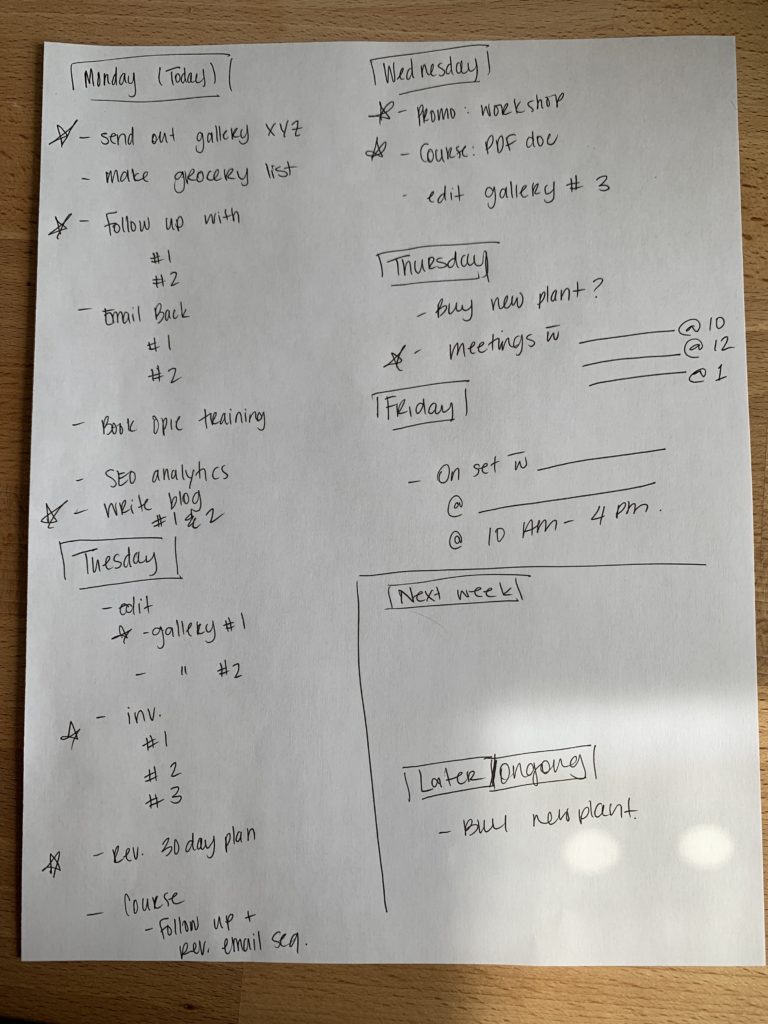Mind mapping aka ‘brain dumping’ is one of the better and easily used habits that has stuck with me for years to clear my head. Because 9 times out of 10 I am an anxious bean on any given Monday morning.
My head is usually running 200 miles a minute and the paralysis of where to start with my to-do list is HIGH. So what do I do? I start mind mapping and get all my thoughts out.
This is actually a re-write of a previous blog post I had done like 2 years ago or something — and while the method is similar, the outcome is now different.
When I originally wrote it, it was in the name of “productivity” and ways to prioritize certain things in my business as I worked from home. While I now cringe over the productivity part (because productivity ≠ worthiness), mind mapping truly does cut some of the noise out of your head.
While I usually mind map on a Monday morning, I would consider doing this on a Sunday night to reduce the Sunday scaries.
Anyways, shall we get to it?
Tl;dr
- Make a word cloud with all your thoughts
- Write them into a master list
- Prune your list
- Organize them into lists for each working day of the week or by the categories: this week, next week, ongoing, and future projects
- Only have 2-3 tasks per day starred, everything else is bonus
- Whatever doesn’t fit moves to next week
How to easily use mind mapping/brain dumping to clear your head
Step 1 — Mind Mapping The 10 Minute Word Cloud
Set a timer for 10 minutes, grab a blank sheet of paper, write your name in the centre of the page and circle it.
Like we did in grade school, we’re going to create a word cloud. For the next 10 minutes, every random thought, task, reminder, future plans, write it down.
The example below is a bit tidier than what an actual mind mapping session for me looks like. Your mind map doesn’t have to make sense to anyone else but you.
- Stick to it for the entire 10 minutes. Sometimes things can up as you sit idle
- It might feel overwhelming but at this stage, we’re just trying to get everything out

Step 2 — Creating Your Mind Mapping Master List
Congrats, you’ve now just completed your first mind map. At this point you may be thoroughly overwhelmed at the number of things you’ve written down. But flip the script and think to yourself — WOW LOOK AT ALL THE SPACE I NOW HAVE IN MY HEAD.
Grab another sheet of paper and organize everything into a list so it’s easier on the eyes, we will call this the master list.
I recommend starting at the top of your mind map/brain dump and working clockwise. Don’t worry about ordering things now, just get them down in a list for easy reading.
Grab a highlighter and highlight as you work through the map. A pen works great too.

Step 3 — Pruning Your List
Pruning. Yes, like for plants. Go through your list and be honest with yourself. Are you going to actually ever do some of these things? Is this something someone else can do? Is this even important for you to do?
Ask the tough questions and cross all the things that YOU don’t actually have to do off the list.
Ah, much better.
Step 4 — Creating your schedule for the week
Okay! Grab another sheet of paper and let’s get organizing and prioritizing. There are 2 ways you can organize your list from this point out depending on your style.
The first way you can organize it is by the following categories: this week, next week, ongoing, and future projects. This method is more ~*go with the flow*~ and gives you more leeway throughout the week. I stopped using this method since I would hyper schedule more than what I could take on, but it could work for you.
The second and my current method is to organize by the days of the week. I’ve found this way to help me a lot more, and here’s why:
- My brain struggles to shift out of the Monday to Friday mindset no matter how much I’ve tried
- I have an easier time powering down at the end of the day when I know what to anticipate
- This reduces the panic over what task I should be focusing on

Step 4.1 — My personal plan for the week
So let’s go through how I like to do this:
I try to reserve Mondays to work on my business and urgent things that need to go out. I also schedule small tasks/loose ends that are quick to finish as it helps me with my confidence as I start the week.
Thursday is when I schedule all my meetings so I can stay in a similar headspace all day.
We’ll call this list the plan for the week, and I’ll write Monday at the top. I’ll add all the easy small tasks I know I can accomplish under this column. From there any urgent tasks as well as any “working on the business” tasks are added.
Step 4.2 — Less is more
Rinse and repeat, and continue to add items to each day, and remember to highlight or cross things off your master list as you go.
Avoid overwhelming yourself by limiting your list to 2-3 focus tasks per day. I put a star beside these so I know it’s the focus for the day. Everything else is essentially a bonus if I get it done.
This method allows me to power down at the end of the day with less guilt, since I know that the important things are done.
Step 4.3 — Less is more pt. 2
If there are more things on your master list than space in a week, don’t fret! Move them to next week or create an ongoing and/or future projects column.
The point of this is to free up space in your brain and help you prioritize stuff to make your week easier, not to optimize your productivity and have you cramming in ALL OF THE THINGS in 7 days. The old me would have done that, the new me really likes her week nights and weekends to herself.
P.S. If you’re like, but Pam I have no idea how long it realistically takes for me to finish tasks, may I consider trying out a time study? During a time study, you record what you do in a day for 2 weeks to see how you’re actually spending your time. The best way I’ve found to do it is by setting a timer for every 2 hrs so you remember to write it down. There are articles out there that can help you with this, maybe it’s an article for later that I’ll write too.
Step 4.4 — The mind mapping stragglers
Any items that aren’t finished at the end of the week get moved to the next week.
Step 5 — Say no to hyper scheduling
I used to hyper schedule to the point of forgetting the google calendar is a 24-hour schedule, not an 8 hour one. Over time that led to some pretty sweet burnout (I am being facetious here, it was not sweet).
At this point in time, the only things that are entered in my google calendar are appointments, meetings, photoshoots, events, etc. Stuff that has a specific time and date where it needs to happen.
Everything else that needs to be done? I work it off of my sheet of paper. It gives me time, space, and flexibility. It also means I can take the time I need to finish tasks without a stressful time limit.
I remind myself, I have these 2-3 tasks for today, everything else is a bonus. I find this method a much kinder way to treat myself as I navigate small business land and working from home.
It doesn’t mean I always get things done, don’t take mental health days if I need it, or just sometimes throw it all in the garbage. But it’s a start.
Conclusion
I hope you found this helpful if mind mapping/brain dumping is something you’ve considered trying and didn’t know where to start or you’re feeling fuzzy around the corners/feeling anxious and need to try a new method to find some structure.
I really need to stress, the goal of mind mapping/brain dumping isn’t to then hyper schedule or become more productive. It’s to help you clear your head so you don’t feel so anxious about what you have to do/what you think you should do. It’s so you can then have more space in your life and settle into a more ideal lifestyle — whatever that may look like for you.
Comments +